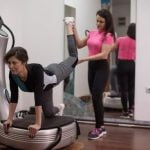Are you curious about how fitness apps accurately measure your exercise routine? In the age of digital health and wellness, fitness apps have become an essential tool for tracking our physical activity. One question that often arises is: how does the fitness app measure exercise?
The accuracy of this measurement is crucial for monitoring progress and achieving fitness goals. In this article, we will explore the various methods and sensors used by fitness apps to measure exercise, as well as the importance of accurate measurement for optimal fitness progress.
Fitness apps rely on a variety of sensors to measure exercise, including GPS, accelerometers, and heart rate monitors. These sensors play a crucial role in tracking steps, distance, heart rate, specific workout details, and estimating calorie burn during physical activities. Understanding how these sensors work to capture data is fundamental in comprehending the accuracy of exercise measurement in fitness apps.
When it comes to tracking steps and distance, GPS and accelerometers are used by fitness apps to provide an estimate of our physical movement. But how accurate are these measurements? Furthermore, heart rate monitors are employed to gauge exercise intensity and calorie burn.
How reliable are these measurements in providing accurate feedback on our workouts? These questions will be explored as we delve into the world of fitness app technology. Join us as we uncover the mechanisms behind the measurements made by your favorite fitness app.
The Role of Sensors in Fitness Apps
Fitness apps rely on a variety of sensors to accurately measure exercise and track fitness progress. These sensors play a crucial role in providing detailed information about physical activity, which allows users to monitor their workouts and make informed decisions about their fitness goals. Here are some of the key sensors used in fitness apps and how they contribute to exercise measurement:
- GPS: Global Positioning System (GPS) technology is commonly used in fitness apps to track outdoor activities such as running, cycling, and hiking. GPS sensors can provide accurate data on distance traveled, pace, and route taken during exercise.
- Accelerometers: These sensors are able to detect movement and measure acceleration, which allows fitness apps to track steps taken, distance covered, and even provide feedback on running technique.
- Heart Rate Monitors: Many fitness apps integrate with external heart rate monitors or utilize the built-in heart rate sensors in smartphones or wearable devices. Monitoring heart rate during exercise helps determine exercise intensity, calorie burn, and overall cardiovascular health.
Understanding how these sensors work within fitness apps is essential for users looking to accurately measure their exercise routines and set achievable fitness targets. By leveraging the data provided by GPS, accelerometers, and heart rate monitors, users can gain meaningful insights into their workouts and progress towards their fitness goals. So next time you wonder “How does the fitness app measure exercise?” remember the crucial role played by these sensors in tracking your physical activity accurately.
Tracking Steps and Distance
Fitness apps play a crucial role in tracking exercise, allowing individuals to monitor their physical activity and progress towards fitness goals. One of the key aspects of exercise measurement in fitness apps is the tracking of steps and distance, providing users with valuable data on their daily movement and overall activity levels.
Utilization of GPS and Accelerometers
Fitness apps often rely on GPS technology to track outdoor activities such as running, walking, or cycling. GPS allows for accurate measurement of distance traveled and provides valuable insights into the pace and route taken during the workout. Additionally, accelerometers are utilized to measure movement and steps taken throughout the day, offering a comprehensive view of overall physical activity.
Accuracy of Measurement
The accuracy of step and distance measurement in fitness apps can vary depending on the type of physical activity and environmental factors. For outdoor activities, GPS technology generally provides reliable measurements. However, when it comes to indoor workouts or activities with limited GPS reception, accelerometers play a more significant role in determining step count and distance traveled. It’s essential for users to understand these factors in order to interpret their exercise data effectively.
Impact on Exercise Progress
By accurately measuring steps and distance, fitness apps enable users to set specific targets for daily activity levels and gradually increase their physical exertion over time. This data also allows individuals to track their progress towards weight loss or cardiovascular fitness goals, providing tangible evidence of improvements in overall health. Understanding how fitness apps measure exercise in terms of steps and distance is therefore vital for utilizing this information effectively in pursuit of optimal fitness progress.
Monitoring Heart Rate
Fitness apps have revolutionized the way individuals track and monitor their exercise routines, providing valuable insights into their physical activity levels. One of the key components of exercise measurement is the monitoring of heart rate, which plays a crucial role in understanding exercise intensity and calorie burn. These apps employ various sensors to accurately measure heart rate and provide users with valuable data for optimizing their workouts.
When it comes to monitoring heart rate, fitness apps often utilize built-in or external heart rate monitors that are synced with the user’s smartphone or wearable device. These monitors measure the user’s heart rate through optical sensors that detect blood flow and pulse in real time. Additionally, some fitness apps are also capable of integrating with chest strap heart rate monitors for even more precise measurements during high-intensity workouts.
In addition to monitoring heart rate during workouts, fitness apps use this data to estimate calorie burn more accurately. By analyzing the user’s heart rate throughout the workout session, these apps can provide a more comprehensive view of the energy expenditure during different types of exercises.
This enables users to make informed decisions about their workout intensity and duration based on their fitness goals. Overall, by understanding how fitness apps measure exercise through heart rate monitoring, individuals can optimize their training regimens for better results.
Recording Workouts
Fitness apps have become an integral part of many people’s exercise routines, helping them track their progress and stay motivated. One of the key features of fitness apps is their ability to record workouts, providing users with valuable data about their exercise sessions. But how does the fitness app measure exercise during these workouts?
One way that fitness apps measure exercise during workouts is by tracking and recording specific details such as reps, sets, and duration. This information is often inputted manually by the user, allowing them to keep a detailed log of their strength training or cardio sessions. Additionally, some fitness apps are equipped with pre-set workout programs that automatically track the user’s progress as they follow along with the exercises.
Another important aspect of measuring exercise during workouts is determining the intensity of the session. Fitness apps may utilize heart rate monitors to track the user’s heart rate throughout the workout, providing valuable data on calorie burn and exercise intensity. By accurately measuring heart rate, these apps can give users a better understanding of how their body is responding to different workout routines.
In addition to tracking specifics like reps and sets, GPS and accelerometers are also used by fitness apps to measure distance covered during outdoor activities such as running or cycling. This allows users to see how far they’ve traveled and at what pace, providing important data for those who are training for a race or simply want to monitor their progress over time.
| Measurement Method | Accuracy |
|---|---|
| Heart Rate Monitoring | Accurate measurement of calorie burn and exercise intensity |
| Distance Tracking (GPS and Accelerometers) | Generally accurate for outdoor activities |
| Manual Input for Reps, Sets, and Duration | Depends on user input but can be very accurate if done diligently |
By utilizing various methods such as manual input, heart rate monitoring, and distance tracking through GPS and accelerometers, fitness apps are able to provide comprehensive measurement of exercise during workouts. This data can be invaluable for individuals looking to improve their fitness levels or achieve specific goals related to strength or endurance.
Measuring Calories Burned
Fitness apps employ various methods to estimate the number of calories burned during exercise. Understanding how fitness apps measure calorie burn can provide insight into the accuracy of this measurement and help users make informed decisions about their fitness goals.
Estimating Calorie Burn
Fitness apps use a combination of user input data, such as age, weight, and gender, along with exercise metrics like heart rate and duration to estimate the number of calories burned during a workout. By inputting personal information, users allow the app to customize calorie burn calculations based on individual factors that influence metabolism.
Factors Affecting Accuracy
The accuracy of calorie burn measurement in fitness apps can be influenced by various factors. These include the precision of heart rate monitoring, which may vary based on the type of activity and device used. Additionally, the level of intensity during an exercise session and individual metabolic differences can impact the accuracy of estimated calorie burn.
Utilizing User Feedback
To improve the accuracy of calorie burn estimation, many fitness apps prompt users to provide feedback on their perceived effort level during a workout. This subjective input can be used to refine future calorie burn estimates for similar activities and enhance overall tracking precision.
Understanding how fitness apps measure exercise can help individuals make informed decisions about their health and wellness. By considering the methods used to estimate calories burned during workouts, app users can gain greater insight into their progress and optimize their fitness routines accordingly.
Comparing Different Fitness Apps
Fitness apps vary in the way they measure exercise, and it’s important to understand how each app’s measurement features differ to choose the one that aligns with your fitness goals. Let’s take a look at some popular fitness apps and compare their exercise measurement capabilities.
One of the most popular fitness apps, Strava, uses GPS to track outdoor activities like running and cycling, providing accurate measurements of distance, pace, and elevation. However, for indoor workouts, it relies on users inputting data manually which may not be as precise.
Another well-known app, MyFitnessPal, integrates with various activity trackers and heart rate monitors to provide comprehensive exercise measurement. It also estimates calorie burn based on the type and duration of the workout. The accuracy of this measurement depends on the precision of the connected devices.
Nike Training Club is another app that offers a wide variety of workout programs with detailed exercise measurement. It tracks reps, sets, and duration for strength training exercises, providing a comprehensive overview of your workout intensity. However, it may not be as accurate in measuring distance for outdoor activities compared to GPS-based apps like Strava.
By comparing these different fitness apps and their exercise measurement capabilities, individuals can make an informed decision about which app best fits their fitness needs.
| Fitness App | Exercise Measurement Features |
|---|---|
| Strava | GPS tracking for outdoor activities; manual input for indoor workouts |
| MyFitnessPal | Integration with activity trackers & heart rate monitors; calorie burn estimation |
| Nike Training Club | Detailed tracking of reps, sets & duration for strength training; less accurate for outdoor activity distance |
The Importance of Accurate Measurement
Accurate measurement is crucial in the world of fitness apps, as it plays a significant role in tracking exercise and monitoring progress. The accuracy of exercise measurement directly impacts the ability of users to set and achieve their fitness goals effectively. Understanding how fitness apps measure exercise is essential for individuals who rely on these tools to guide their workout routines and overall fitness journey.
One of the ways that fitness apps measure exercise is through the use of sensors, including GPS, accelerometers, and heart rate monitors. These sensors work together to track various aspects of physical activity, such as steps taken, distance covered, heart rate during workouts, and calories burned. By utilizing these sensors, fitness apps are able to provide users with valuable data regarding their exercise habits and performance.
Additionally, fitness apps are capable of tracking and recording specific workouts, including the number of reps and sets performed, as well as the duration of each session. This detailed information allows users to analyze their workout patterns and make necessary adjustments to their fitness routines. Furthermore, some fitness apps also estimate calorie burn based on the exercise measurement data collected.
However, it’s important to consider the factors that influence the accuracy of this estimation, such as individual metabolism and body composition. Overall, understanding how fitness apps measure exercise provides users with valuable insights into their physical activity levels and progress towards reaching their fitness goals.
Conclusion
In conclusion, the accuracy of exercise measurement in fitness apps is crucial for individuals to track their progress and achieve their fitness goals effectively. The use of various sensors such as GPS, accelerometers, and heart rate monitors allows these apps to measure steps, distance, heart rate, specific workouts, and calorie burn. While these measurements can provide valuable insights into one’s fitness activities, it is important to recognize the limitations and factors that may influence the accuracy of these measurements.
It is evident that different fitness apps offer varying degrees of exercise measurement features. Some may excel in tracking steps and distance through GPS and accelerometers, while others may focus on monitoring heart rate and estimating calorie burn during workouts. Understanding the strengths and weaknesses of different apps when it comes to exercise measurement can help users choose the most suitable app for their fitness needs.
Ultimately, for individuals striving for optimal fitness progress, it is essential to appreciate how fitness apps measure exercise. By recognizing the importance of accurate measurement in these apps, users can make informed decisions about their workout routines and set realistic fitness goals. Therefore we encourage users to strategically utilize the information provided by these technologies as tools to guide them on their journey towards better health and wellness.
Frequently Asked Questions
How Does Activity App Measure Exercise?
The Activity app on the Apple Watch measures exercise by tracking your movement and heart rate. It uses algorithms to determine different types of exercises, such as walking, running, or cycling.
What Triggers Exercise Ring on Apple Watch?
The exercise ring on the Apple Watch is triggered by sustained activity that raises your heart rate. This can include activities like brisk walking, jogging, or any workout that gets your heart pumping.
How Accurate Is the Fitness App on Phone?
The accuracy of the fitness app on a phone can vary depending on the type of phone and its sensors. Generally, most modern smartphones are able to provide reasonably accurate fitness tracking data, but for precise measurements, dedicated fitness devices may be more reliable.

Passionate about providing useful information to anyone with an interest in the field of Personal Training, I strive to pass on to our readers quality information and to answer any questions about Personal Trainers, the work they do and how to become one.





